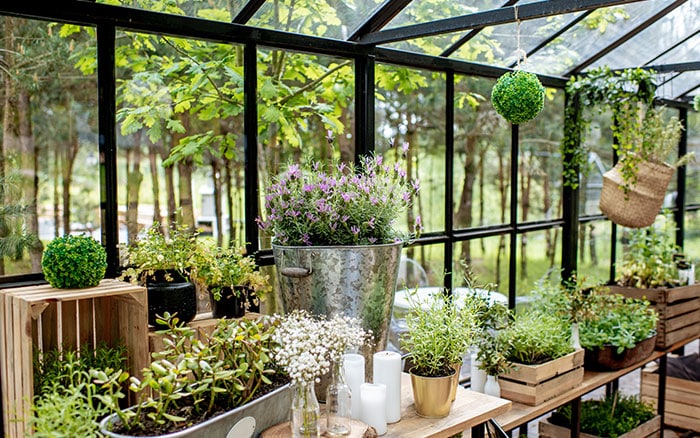A greenhouse can be a real asset in the garden. Personally, I enjoy my greenhouse most on rainy days. Pottering around in the warmth, nurturing my seeds as the rain plinks and plonks on the glass above my head.
Available in all shapes and sizes, for all needs, greenhouses are a sure-fire way for you to elevate your gardening to the next level and escape into the pure enjoyment of growing your own plants.
Green on greenhouses
If you’re new to the greenhouse game, a greenhouse is an escape into a world of growing wonder! And it’s not just about using it as a tool, but as a place to escape as well. Your greenhouse becomes a room in which you can produce new growth, like an artist’s studio. It can be set up for quiet reflection or provide the perfect space for production.
As a protected growing site, it also enables you to extend the growing season, giving you access to the joys of gardening for more months out of the year.

As your greenhouse is somewhat shielded from the seasons, you have the opportunity to grow seedlings, tender plants and vegetables, or even exotics, where you may not have before. So get excited about out-of-the-box gardening and get planning what to plant.
Lost in location

Where you build your greenhouse is so important. But deciding where to site it will be determined by what you want to grow in it. Every garden is different, only you will know which parts of your plot receive full, morning, or evening sun, and which are lacking thereof.
Don’t forget that the sun’s position will change throughout the year too. My biggest tip is to avoid situating under trees, not only is there shade but a risk of falling branches and bird waste.
Ideally, you will have the greenhouse’s longest side facing South for optimal sun over winter—this will maximise access to sunlight when plants need it most! But, if you’re installing a greenhouse, it’s important to make sure it’s accessible from the house too. After all, what good is a perfectly sited greenhouse you never visit because it’s too far to venture down the garden path.
Sound structure
It’s best if your greenhouse sits upon a solid foundation. Not only will it give you a stable footing year-round but it’s easier to keep clean. You may choose only to pave down the centre for access to both sides.
If you do want the entire floor paved, just remember to build your base larger than the greenhouse itself to allow room for the framework and for steady footing around the exterior, which is not only helpful when cleaning but enables you to grow around the perimeter of your greenhouse in grow bags and pots.

For tiny gardens, mini-greenhouses or lean-tos (where a wall becomes one side of it) are ideal, and you don’t have to lose on functionality either. Some mini-greenhouses are still walk-in, or you can opt for ones that you access from the outside—but these don’t offer any cover for you in damp weather.
Glassy n’ classy

The glass panes in your greenhouse help with growing through the diffusion of light and trapping the warmth of the sun—so keep them clean. You can buy specialist cleaner for the garden centre for this.
Clean off algae or moss and disinfect the glass as you go too. This is best done in winter before the growing season starts up and it’s chock-full of plants.
Double glazing will give you about three times the protection from heat loss as single panes, but you can do this with bubble plastic as insulation in the winter.
Accessories to please
With any outdoor structure, you need to consider varying temperature and ventilation needs throughout the year.
For this, larger hard-standing greenhouses are easier to control; with the ability to have openings for ventilation and heating too. You can buy automatic window openers to vent your greenhouse on hot days.

You can set up partitions for sectioning off growing needs. And you can be quite clever with the internal fit to get an organised set-up.
Greenhouse staging – the workbench positioned at waist height – and shelving, which is the narrower storage platform positioned above, will maximise the space for your specific needs. I’d recommend placing trays with capillary matting on your benches to aid watering and humidity.
Else, I’ve got a potting station with sides fitted specially to hold the compost in, ready to plant up—this makes potting so easy and enjoyable.
Tip:
You can passively heat your greenhouse
by using 55-gallon water barrels which have
absorbed heat during the day to release it at night!
Whichever route you take, greenhouses, or similar, can give you an opportunity for growing more plants. And, in my book, that’s never a bad thing! So, set up a glorious greenhouse to garden yourself gleeful.
Happy gardening everyone!
Reader questions
Are there any cheap ways to start growing?

You don’t need all the bells and whistles to start growing, you can sow seedlings into empty toilet rolls to start. And potatoes can be started out in egg boxes, or cress grown in eggs shells. Take a look at my Pinterest page for a multitude of gardening hacks that’ll keep costs down.
My indoor hyacinth is turning brown; what can I do?

The hyacinth browning might indicate it’s finished for the year, shedding flowers as it goes into dormancy. However, check the soil is only slightly damp as overwatering indoor hyacinths is very common and can also turn the flowers brown. Feed regularly, then plant outdoors.

Leave A Comment